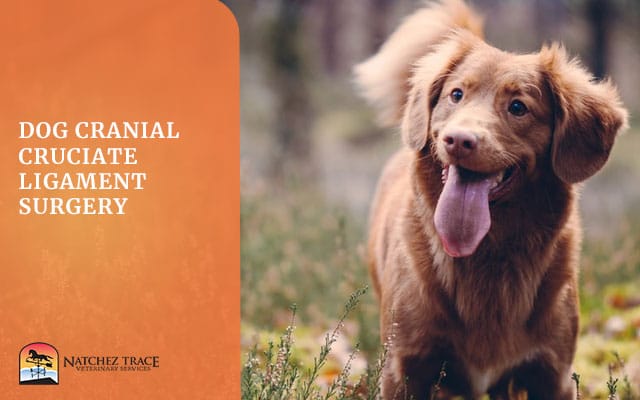Dog Cranial Cruciate Ligament Surgery: Why Would a Dog Need this Surgery?
Cranial Cruciate Ligament damage is a rip or tear of one of the cruciate ligaments. It is usually the result of slow, subtle degeneration of the ligament that has been taking place from within rather than being the result of an injury to a previously healthy ligament.
The cruciate ligaments located within the knee in an “X” pattern that connects the femur (“thigh bone”) to the tibia (“shin bone”). The cranial cruciate ligament’s function is to stabilize the tibia and keep it from sliding out of position, hyperextending, and twisting.
Because of this, many dogs that have damaged cruciate ligament in one knee will experience the same in the other knee.
Diagnosis of a damaged cranial cruciate ligament is determined by observation of the dog’s gait, palpation of the dog’s knee, and verification with x-rays. Hind leg lameness is the most common sign of a CCL rupture. The dog may also experience pain and swelling of the joint. Sometimes a crackling sound can be heard when the dog walks due to the bones rubbing together (crepitus). There may also be a popping or snapping sound when walking if the knee cartilage has also been damaged.
Dog Cranial Cruciate Ligament Surgery: Are Certain Dog Breeds More at Risk?
Cranial cruciate rupture is possible in any breed of dog, but it is most commonly seen in:
- Cocker Spaniel
- Rottweiler
- Miniature Poodle
- Toy Poodle
- Lhasa apso
- Bichon Frise
- Golden Retriever
- Labrador Retriever
- German Shepherd
- Mastiff
- Large Dogs
- Overweight Dogs
- Older Dogs
Dog Cranial Cruciate Ligament Surgery: The Procedure Explained
The surgery most often used to repair cranial cruciate ligaments in dogs is Extra-capsular Suture Stabilization, which is also called “Ex-Cap Suture”, “Lateral Fabellar Suture Stabilization”, or “The Fishing Line Technique”.
The theory behind this procedure is that the function of the damaged cranial cruciate ligament can be replaced with a heavy monofilament nylon suture placed in a parallel fashion to the original cruciate ligament, except on the outside of the joint. (The ligament is on the inside of the joint.) This suture stabilizes the tibia (“shin bone”) relative to the femur (“thigh bone”) and allows normal knee movement.
After the surgery, the dog’s activity must be highly restricted for approximately 4 months. Activity to early or excessively can cause the surgery to fail. Special exercises and/or physical therapy is recommended to regain range of motion after surgery. The cost of this surgery is usually around $1800.
Watch a Video of the Procedure
Watch Dog Cranial Cruciate Ligament Surgery
Powerful Tools to Help Your Dog’s Cruciate Ligament Challenges
You can make many quick and easy changes at home to help you give your dog an edge on easing tendon and ligament challenges.
- Learn more about torn ligaments and cruciate disease.
- Provide joint support. PET | TAO Harmonize Joint is a blend of Eastern herbs and Western supplements working together to lubricate and restore your dog’s joints.
- Ease your dog’s discomfort naturally. PET | TAO Comfort is a blend of Eastern herbs and Western supplements to soothe your dog’s arthritic challenges to make him/her more comfortable.
- Try PET | TAO Freeze Dried Beef Liver Treats. According to TCVM, liver controls tendons and ligaments. As few as 5-6 treats per day can make a huge difference in your dog’s tendon and ligament health!
- Try a Blood-building TCVM Diet. PET | TAO Solution Zing canned dog food builds Blood. According to TCVM, Blood deficiency leads to ligament tears.
- Learn more about TCVM Herbal Remedies. Chinese medicine offers many amazing natural solutions for ligament and cruciate challenges. Some good examples are:
Clinical Studies
- Canine Cranial Cruciate Ligament Rupture
- Effect of surgical technique on limb function after surgery for rupture of the cranial cruciate ligament in dogs.
- Evaluation of Fibular Head Transposition, Lateral Fabellar Suture, and Conservative Treatment of Cranial Cruciate Ligament Rupture in Large Dogs: A Retrospective Study
- Experimental studies of acute anterior cruciate ligament injury and repair.
- Treatment of Cranial Cruciate Ligament Injuries in Dogs
Sources:
- AKC Canine Health Foundation
- Colorado State University
- Rupture of the Cranial Cruciate Ligament
- Yancy Clinic of Veterinary Medicine








